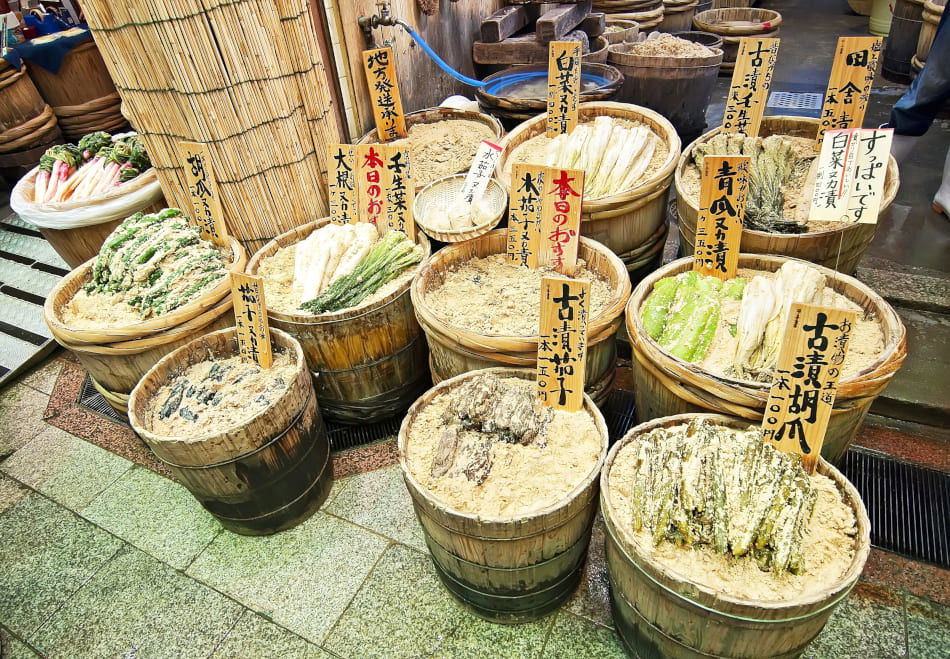Table of contents:
Tsukemono – Japanese Pickled Vegetables
In Germany, pickled cucumbers are the most popular pickled vegetables. The Japanese version is called "Tsukemono" and consists of various types of vegetables. Its fresh, sweet-sour taste enhances many dishes and, although it is only a small side dish, it is still an important part of typical Japanese meals.
Tsukemono goes particularly well with rice and meat dishes, but it also tastes wonderful with sushi or as a snack with sake or beer. It is also a pretty garnish for dishes such as Japanese curry (Kare). Tsukemono has a refreshing and cleansing effect and creates a pleasant balance for rich foods.
Tsukemono – The Health Aspect
Fermentation gives the already healthy vegetables an extra boost of nutrients, vitamins, antioxidants and probiotics. Tsukemono are macrobiotic, which has a positive effect on gut health, and they also regulate excess acid in the stomach.

Tsukemono – So Diverse
Tsukemono can be made with almost any vegetable and pickled in different liquids. This creates countless variations of the popular side dish. There are, among other things, Tsukemono in rice vinegar, salt, soy sauce, rice bran and miso, each liquid giving a special taste. And of course, every family also has its own Tsukemono family recipe. In Japanese supermarkets you can buy ready-made Tsukemono and choose from at least 20 to 50 different varieties.
Here are the most popular:
- Amazuzuke (rice vinegar and sugar)
- Asazuke (brine)
- Karashizuke (mustard)
- Kasuzuke (sake yeast)
- Kōjizuke (Kōji mushroom (yeast))
- Misozuke (miso)
- Nukazuke (rice bran (Nuka))
- Satōzuke (sugar)
- Shiozuke (salt)
- Shiroppuzuke (syrup)
- Shōyuzuke (soy sauce)
- Suzuke (vinegar (rice vinegar))
- Wasabizuke (wasabi)
Which Tsukemono are the most popular?
Depending on the preparation method and the vegetables used, the Tsukemono has its own name. Here you will find the most popular variants. Try them out and find your favorite!
Umeboshi
Umeboshi are pickled plums that have a very special taste. They are sweet, sour and salty at the same time - really delicious. In Germany this specialty is called "salt plum", although it is more comparable to apricots. But I will go into more detail about this in a separate post.

Takuan
Takuan is pickled radish, which shines in a yellow color. It is first dried and then pickled in rice bran for several months. It gets its special color from the dried gardenia fruit, which is added to it during marinating. If you buy Takuan at the supermarket, it is unfortunately usually artificially colored. By the way, you can make delicious vegan sushi with Takuan.

Beni shōga
Beni shōga is pickled ginger cut into strips. It is easy to recognize because of its ruby red color. Its crisp-fresh taste goes well with meat dishes and fatty foods and you often find it on the beef dish Gyudon and on noodles like Yakisoba . It can also be fried as tempura, giving it a slightly different taste.

Sushi Ginger (Gari)
The pickled ginger that is typically served with sushi is also part of Tsukemono. Unlike Beni shōga, Gari has a sweet and spicy taste and is perfect for getting rid of the fishy taste. It is also cut into very thin slices.
Rakkyo
Rakkyo look like garlic cloves, but looks are deceiving. They are Chinese onions that taste similar to shallots. They are pickled in salt, soy sauce or sweet vinegar and served with Japanese curry. Here is a delicious recipe for Kare Raisu .

Hakusaizuke
Hakusaizuke is pickled Chinese cabbage. But the taste is quite different from its famous relative, Korean Kimchi. It tastes slightly sour and smells deliciously fresh of lemon. The original recipe uses the Yuzu lemon. I love Hakusaizuke and eat it very regularly.
But there are also many other Tsukemono varieties. Vegetables that are often used are cucumber, eggplant, ginger, cabbage, radish, plums and onions, for example.
Making Tsukemono Yourself
Some types of Tsukemono can be prepared in just a few days, while others need to be pickled for several months before they are edible. "Asuzake" is a very quick type of Tsukemono, where the fresh vegetables are only pickled for a few hours or overnight. You can easily make Tsukemono yourself. It is important to follow the right steps: First, the chosen vegetable is grated finely and then placed in a liquid for pickling. While it rests, it must be weighted down. For this, you can use two nested bowls, between which the Tsukemono is placed. The variant with special Tsukemono pots is a little more convenient. The purchase is worthwhile if you make Tsukemono more often. Here we present three different pots:
The Classic
At Amazon you can find a typical Tsukemono pot for around 25 Euros. You simply put the vegetables and the liquid in, season it and then screw the press down until it is well sealed. After a few days you can already try your homemade Tsukemono.

The Smaller Version
If you don't have that much space in your kitchen cabinets, then this small pot might be right for you. Price-wise it costs about the same as the classic pot.

Authentic Tsukemono Pot
If you want to make Tsukemono authentically, then you can use this ceramic pot. It is not as practical as the plastic versions, but it looks really chic. At Amazon, such a pot is available for around 35 Euros.

Tsukemono: A Surprising Side Effect
We have already written that Tsukemonos are very tasty and also quite healthy. But they have another advantage. Some varieties, such as Umeboshi, are antibacterial. That's why people like to pack them in Bento boxes (Japanese lunchboxes), so the food will keep for several days even without a refrigerator!


Comments
Genau was ich gesucht habe ...
Tanja, endlich etwas durchdachtes, genial Danke
hallo, gibt es rezepte zu den verschiedenen tsukemono auf dem bild ganz oben? sehr guter artikel!
Hallo ich suche einen länglichen Gärtopf für mein Nukabett. Die habe ich nur in Plastik gefunden. Dieses lässt aber Licht durch. Muss das Nuka dunkel lagern?
Sehr spannende Tipps, danke.. Wo finde ich den erwähnten Blog, bitte? Ich platze gerade vor Ideen. Viele Grüße!